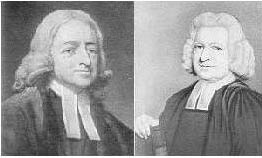| John Wesley d. 2 March 1791 |
Charles
Wesley d. 29 March 1788 |
Renewers of the Church

The Wesley brothers, born in 1703 and 1707, were leaders of the evangelical revival in the Church of England in the eighteenth century. They both attended Oxford University, and there they gathered a few friends with whom they undertook a strict adherence to the worship and discipline of the Book of Common Prayer, from which strict observance they received the nickname, "Methodists." Having been ordained, they went to the American colony of Georgia in 1735, John as a missionary and Charles as secretary to Governor Oglethorpe. They found the experience disheartening, and returned home in a few years. There, three days apart, they underwent a conversion experience. John, present with a group of Moravians who were reading Martin Luther's Preface to the Epistle to the Romans, received a strong emotional awareness of the love of Christ displayed in freely forgiving his sins and granting him eternal life.
Following this experience, John and Charles, with others, set about to stir up in others a like awareness of and response to the saving love of God. Of the two, John was the more powerful preacher, and averaged 8000 miles of travel a year, mostly on horseback. At the time of his death he was probably the best known and best loved man in England.
Although Wesley found it natural to approach the Gospel with habits of thought formed by a classical education, he was quick to recognize the value of other approaches. The early Methodist meetings were often led by lay preachers with very limited education. On one occasion, such a preacher took as his text Luke 19:21, "Lord, I feared thee, because thou art an austere man." Not knowing the word "austere," he thought that the text spoke of "an oyster man." He spoke about the work of those who retrieve oysters from the sea-bed. The diver plunges down from the surface, cut off from his natural environment, into bone-chilling water. He gropes in the dark, cutting his hands on the sharp edges of the shells. Now he has the oyster, and kicks back up to the surface, up to the warmth and light and air, clutching in his torn and bleeding hands the object of his search. So Christ descended from the glory of heaven into the squalor of earth, into sinful human society, in order to retrieve humans and bring them back up with Him to the glory of heaven, His torn and bleeding hands a sign of the value He has placed on the object of His quest. Twelve men were converted that evening. Afterwards, someone complained to Wesley about the inappropriateness of allowing preachers who were too ignorant to know the meaning of the texts they were preaching on. Wesley, simply said, "Never mind, the Lord got a dozen oysters tonight."
Charles was the better hymn-writer of the two. He wrote over 6000 hymns, including about 600 for the Sacrament of the Lord's Supper. Some of the better known are the following:
- A charge to keep I have
- And can it be that I should gain
- Author of life divine
- Christ the Lord is risen today
- Christ, whose glory fills the skies
- Come, Holy Ghost, our hearts inspire
- Come, O Thou Traveller unknown
- Come, thou long expected Jesus
- Forth in Thy name, O Lord, I go
- Gentle Jesus, meek and mild
- Hail the day that sees Him rise
- Hark, the herald angels sing,
- Jesus, Lover of my soul
- Let saints on earth in concert sing
- Lo, He comes with clouds descending
- Love Divine, all loves excelling
- Jesus, full of pardoning grace
- Love Divine, how sweet Thou art!
- Thou who camest from above.
- Oh for a heart to praise my God
- Oh for a thousand tongues to sing
- Our Lord is risen from the dead
- Rejoice! the Lord is King
- Soldiers of Christ, arise!
- Ye servants of God, your Master proclaim
It was the intention of the Wesleys and their colleagues that their "Methodist Societies" should be a group within the existing structure of the Anglican Church, but after their deaths the Societies in America, and to a lesser extent in England, developed a separate status.
Acknowledgements:
Text adapted from James Kiefer's Christian Biographies
Image from United
Methodist Church